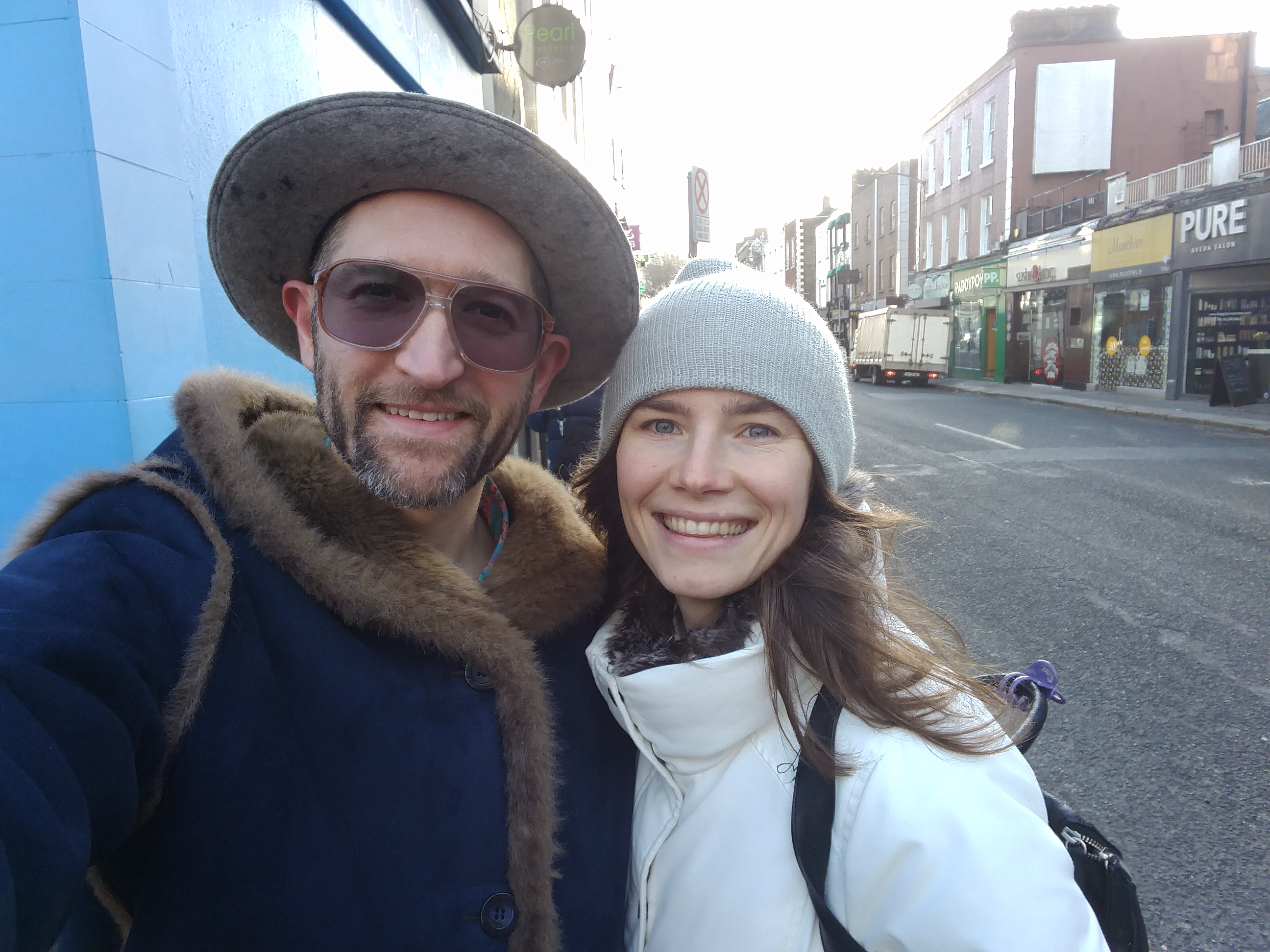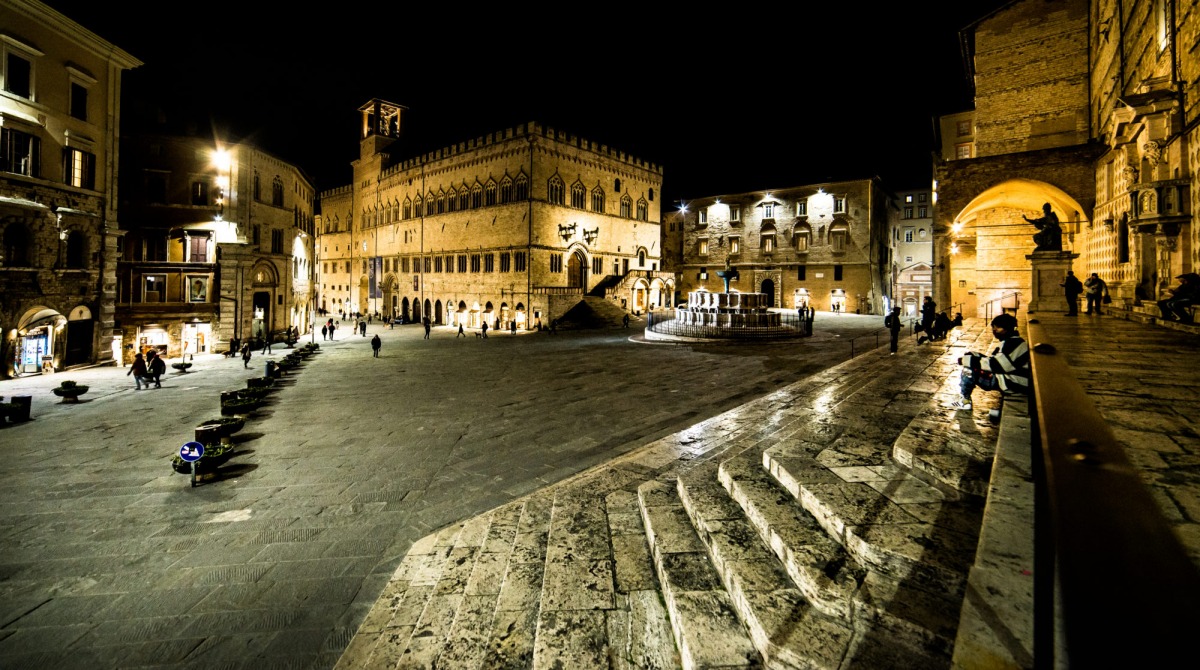Nowhere that I have visited has quite the charm of Umbria, Italy’s throbbing green heart, and only land-locked province apart from the Alpine region. Along its horizon, verdant hills culminate in fortified settlements that act as sentinels over fecund valleys, where wheat fields and vineyards have long sustained a saturnine populace. The lumbering waters of the Tiber snaking through the countryside bestow lush fertility, while in the distance the spine of mountains that form the Apennine range cleaves into view.
The region has strong spiritual traditions: Saint Benedict, who developed the communal model of Western monasticism, hailed from Norcia; while around Assisi Saint Francis saw the divine in all living beings. But inward contemplation has often intertwined with outward savagery, the charming cities bearing the stain of bloodshed from centuries of internecine conflict.
Just as sweet birdsong contains fierce threats to competitors, so the form and grace of Umbria’s built environment belies the violence of perennial power struggles. Extravagant civic architecture was a form of competitive display between the signorie that ruled those city states during the Middle Ages and Renaissance.
First among equals is Perugia, Umbria’s capital and hub. At dusk, imbibing the rising chatter on Piazza IV Novembre, one may assume the light to be eternal, and that the dancing shadows will never give way to the enduring gloom of night.

Into this setting in 2007 strode an insouciant Amanda Knox, then twenty years of age. Enrolling in Perugia’s Universitá per Stranieri, she realised a dream of studying the Italian language on a semester abroad from her native Seattle, a world apart on the distant west coast of America. A familiar student lifestyle followed in those first weeks of term: falling in love; alcohol and cannabis; the irritations of part-time work as a waitress; all this as she nursed the hope of a career as an interpreter.

Universitá per Stranieri, Perugia. Image: Daniele Idini ©
Video footage from the period reveals her as vivacious and quirky, a bundle of mischievous energy whose fair complexion might break a few hearts over the course of her stay. She seemed destined to skip back home to the relative anonymity of grad school, career and family, holding on to fond memories of an old Europe she would rarely, if ever, return to. What lay in store was an altogether different fate, a living nightmare. She retains the role of femme fatale in a film noir that was not of her choosing.
On November 1st, 2007 British student Meredith Kercher was found dead in the apartment she shared with Knox and two other Italian students. Knox and her then boyfriend Raffaele Sollecito were accused of her rape and murder. The prosecution alleged that Kercher had been killed during a sex game gone wrong, with Knox orchestrating proceedings. Crucially, DNA evidence linked Knox to a knife the prosecution claimed could have been the murder weapon. But this evidence was found inadmissible when independent forensic experts found a strong likelihood of contamination of the DNA, leading to Knox and Sollecito’s successful appeal in 2011, ending their incarceration. They were definitively exonerated in 2015 by the Italian Supreme Court. In the meantime, a serial offender, Rudy Guede, was found guilty of the crime and is currently serving a reduced sentence after an early admission of guilt, based on incontrovertible DNA evidence and a confession after he had fled to Germany, from where he was extradited back to Italy.
The circumstance of Meredith Kercher’s horrifying demise gave rise to a mystery play, in which the two main characters are removed from the scene of the awful attack. As the plot unfolds we encounter another articulation of evil no less sinister than that which prompted the fatal assault.
It involved a battle of wills, and wits, between Amanda Knox and her prosecutor Giuliano Mignini, whose bizarre conjectures suggests perverse imaginings. He had been revealed as a fantasist before his attention was drawn to the pretty American student ‘inappropriately’ kissing her boyfriend outside the crime scene. In 2001, the same Mignini, as Perugia prosecutor, had ‘identified’ a satanic sect that supposedly killed women for black masses, which he linked to the unsolved ‘Monster of Florence’ serial murder case. To that he end, he arrested twenty people all of whom were, like Amanda Knox and Raffaele Sollecito, completely exonerated.
In the 2016 Netflix documentary Amanda Knox we meet an unrepentant Mignini, who speaks of his fondness for Arthur Conan Doyle’s Sherlock Holmes. The pipe he sports seems in homage to the Victorian sleuth. It is unsurprising to discover this taste for fantasy fiction, and characterisations of extreme evil. Did he cast himself as the English gentleman – the ‘dandy’ long revered in Italy – defending an idealised damsel? In such imagining Kercher had been killed at the instigation of the promiscuous and drug-addled Knox, who was portrayed as a sinister witch.
We may speculate that Mignini developed a sordid fascination with both Meredith Kercher and Amanda Knox. A devious and enduring campaign against Knox might suggest a Freudian sublimation.
Mignini’s persecution of Knox and Sollecito could be dismissed as a sinister aberration of Italian justice, but for the extent to which his theories found favour among many Italians, stoked by an international tabloid media that latched on to every gruesome conjecture. The prosecution manipulated damaging evidence against Knox, in particular, before the court of international opinion, and a character of ‘Foxy Knoxy’, previously her MySpace handle, was invented. To this end, a policeman masquerading as a doctor lied to her saying she was HIV positive, and encouraged her to write a diary outlining her sexual history, which was then stolen and passed on to the media.
In the documentary Mignini makes the startling boast that ‘normally people say that ‘Nobody is a prophet in his own country’, but that’s not what I experienced’. Casting himself as a Savonarola for our time, he sought to cast away the sins of the world, sins he believed were personified in Amanda. The backdrop to this was a widespread feeling of moral decline in Italy, especially identified with the then prime minister Silvio Berlusconi’s lewd antics. But Mignini’s self-righteousness recalls Shakespeare’s ‘Sonnet 94’: ‘Lillies that fester smell far worse than weeds’.
Mark Williams suggests that a mythology ‘furnishes a culture with a total worldview, interpreting and mirroring back everything that that culture finds significant’. Contemporary Italian culture is still steeped in mythology, whose living presence is emphasised by the ubiquity of ancient ruins. Perugia itself possesses an architectural legacy stretching back to the ancient Etruscans.

The Etruscan Arch or Arch of Augustus, Perugia. Image: Daniele Idini
Italy was only unified in 1861. The following day, the politician and intellectual Massimo d’Azeglio famously said: ‘We have made Italy and, now, we must make the Italians.’ The formidable culture of Ancient Rome was drawn on in particular. For example, the term ‘fascist’ derives from the Latin word ‘fascis’ meaning bundle. ‘Fasces’ is a bound bundle of rods, which had its origin in the Etruscan civilisation and was passed on to ancient Rome, where it symbolised a magistrate’s power and jurisdiction.
That Roman inheritance still exerts influence on the Italian collective unconscious, often importing an ideal of woman as objective beauty and passive agent. Laurens van der Post contrasts the Ancient Greek attitude to women, expressed in Homer’s Odyssey, with that of the Roman, expressed in Virgil’s Aeneid: ‘It is precisely because this journey of Odysseus and his reunion with the eternal feminine that is Penelope, is the blueprint of the Greek story that made Greece, I believe, more creative than Rome.’
Van der Post contrasts Odysseus, who returns to his wife after twenty years of exile, with Aeneas – a Trojan who becomes the first hero of Rome – and symbolically rejects ‘the eternal feminine’, not once but twice. Firstly, in choosing to carry his father Anchises rather than his then wife Creusa, on his back out of a burning Troy; and afterwards, in his memorable rejection of Dido’s love in favour of patriarchal duty.
After many trials Aeneas and his fellow surviving Trojan refugees land in Latium in Italy. There, he has learnt on a mystical Underworld journey, a (male) ancestor will establish the city of Rome. To bring this about, however, he must first subdue the local tribes. Defeating their champion Turnus in mortal combat he wins the hand of the virginal Lavinia, daughter of Latinus, king of the Latins. Critically, Virgil describes her as, ‘the cause of all this suffering, her lovely eyes downcast.’ The unashamed sensuality of Amanda Knox – kissing inappropriately outside a crime scene – was an insult to a Roman ideal of downcast loveliness.
Knox and Sollecito – he as collateral damage it seems – became the victim of Mignini, the latter-day Sherlock. In custody for days on end, and without access to lawyers, the young pair were made to sing. Confessions were extracted and subsequently recanted. In the grip of terror, bizarre fictions emerged.
This is not unusual. Saul M. Kassin describes ‘coerced-internalized false confessions‘, as ‘statements made by an innocent but vulnerable person, who, as a result of exposure to highly suggestive and misleading interrogation tactics, comes to believe that he or she may have committed the crime – a belief that is sometimes supplemented by false memories.’ Kassin cites numerous US cases where innocent parties implicate themselves in crimes in which subsequent DNA evidence definitively reveals they had no involvement. One such instance was the notorious Central Park jogger case, in which a number of young men confessed to a crime and were found guilty, before the real perpetrator came forward and admitted to the crime, saying he acted alone, with DNA evidence corroborating his account.
Amanda Knox is often criticised for implicating Patrick Lumumba, the Congolese boss of the bar she worked in at the time. But who among us knows the scenarios that would spill forth to end a long and tortuous interrogation, after probable trauma in the wake of a horrific murder? The important principle is that confessions extracted under duress are entirely unreliable as evidence, and unworthy of consideration. Any charge of conspiracy over the false accusation should never have been leveled against her.
As far back as 1908 Hugo Munsterberg wrote about a Salem witch confession involving ‘illusions of memory’ in which ‘a split-off second personality began to form itself with its own connected life story built up from the absurd superstitions which had been suggested to her through the hypnotising examination.’ A witch hunt will find “absurd superstitions”, just as a man with a hammer sees nails.
Jung’s conception of evil is useful for examining the aftermath of Meredith Kercher’s murder and rape. His ideas diverge from the Catholic doctrine of Privatio Boni, which identifies evil simply with the absence of good and not as an independent and eternal phenomenon. In contrast, Jung argues: ‘Evil does not decrease by being hushed up as a non-reality or as mere negligence of man. It was there before him, when he could not possibly have had a hand in it.’ Furthermore, he warned: ‘The future of mankind very much depends upon the recognition of the shadow’. The serpent may crawl into the most rarefied of environments.

Shadows in Perugia. Image: Daniele Idini
The evil evident in Rudy Guede’s offence is a sadly familiar story of a dislocated childhood, and a spiral of nefarious deeds, ending in a heinous crime. But Mignini’s actions appear to represent denial of the shadow. He comes across as virtuous – disciplined, abstemious, family-orientated – but he may have failed to countenance an evil lurking within his own nature. This may have led him to build a narrative out of diabolical imaginings, which nearly destroyed the lives of two young people, who will never fully recover from the ordeal.
Jung saw the mechanism of the shadow as accounting for the persecution of Jews through history. He argued that Christians scapegoated Jews in response to their own rejection of the real meaning of Christ. Mignini’s reign of terror fits into a wider phenomenon of targeting individuals for broader perceived failings in a society. The origin of contemporary racism is also located in the inability of communities to live up to standards some members expect, with contagion blamed on an internal enemy.
The Meredith Kercher case became a cause celebre in early twenty-first century in Italy. Television channels featured nightly debates which voyeuristically picked apart the details, while the personalities of the protagonists were relentlessly scrutinised and their images placed on constant display. One may assume it suited Silvio Berlusconi’s government, which controlled most television channels, to saturate the public mind with the protracted case, distracting from the endemic corruption, which would ultimately bring down his government in 2011, the same year as Knox’s successful appeal.
Moreover, it is commonly believed in Italy that official explanations cannot be relied on. The suspicion that there is always something going on behind, ‘dietro’, the surface, produces the common word ‘dietrologia‘, used to refer to a conspiracy. The bizarre details of the Knox-Sollecito case fed a veritable industry in competing interpretations. Besides, a liberal critique could be countered by the racial dimension: the black African languishing in jail, while the white American escapes, plus ca change.
Many Italians are still unwilling to contemplate that the whole Knox-Sollecito prosecution was indeed a bizarre invention. After all, to do so casts grave doubts over the integrity of their entire legal system. This has parallels with the unwillingness of Lord Denning to countenance the ‘appalling vista’ of police criminality in the Birmingham Six, wrongfully found guilty of the Birmingham pub bombings, who spent sixteen years in prison before the Court of Appeal quashed their conviction in 1991. The ‘Umbrian vista’ of a serious miscarriage of justice is still questioned by many Italians.
Douglas Preston argued that the answer for this denial of an unwillingness to recognise a manifest injustice lies in the Italian concept of face (‘la faccia‘) ‘whose deep and pervasive power most Anglo-Saxons who have not lived in a Mediterranean country have a hard time appreciating.’
V

Amanda Knox and Christopher Robinson ‘selfie’, Dublin, February 2018
I met Amanda Knox and her boyfriend the writer Christopher Robinson when they visited Dublin last month. They had arrived in advance of Amanda’s appearance on the Ray D’Arcy Show, her first television interview outside the United States since her exoneration in 2015.
Like most people, I had taken a passing interest in what seemed a bizarre case, piqued more by the Umbrian backdrop to the crime scene than the lurid storylines. In truth, I had not given serious consideration to the guilt or innocence of the protagonist, and only engaged with the case when I met a person whose nature seemed entirely unfitted for the role of psychotic murderess. The more I read, the more my intuition was confirmed.
The protagonists in high-profile cases seem unreal until you actually meet them, or not, as is the case with most of the self-anointed true-crime experts, who search Amanda Knox’s every gesture for ‘signs’ of guilt; bestowing credibility on evidence that was not only inadmissible, but may have been part of a sinister conspiracy.
What is most striking about Amanda is an outgoing disposition, a West Coast woman with plenty of spunk. She and Christopher are a gregarious pair, at ease in the territory of literature, philosophy and languages, the last of which is her specialism. Surprisingly, she gives no impression of bitterness, even towards Italy. Perhaps it is still that failure to play the role of downcast Lavinia bemoaning her fate which evokes suspicion, but why should she restrain a natural joie de vivre?
Nor does she shy away from recalling her experiences: casually dropping in a mention of the aubergine – or ‘egg plant’ – provided in prison; or how she earned the respect of illiterate inmates by writing letters on their behalf (in return at one point a Neapolitan gang pulled her out of a brawl that was getting nasty). Nonetheless, she has admitted to suicide ideation during four years behind bars. Sharing cells with hardened criminals for four years for a crime she did not commit provides a perspective few of us gain.
On their trip I accompanied the couple on a hike along Howth Head, during which she revealed herself as an animal lover, greeting every pooch and kitty as if they were long lost friends. Travelling by train I became conscious of a few gawkers, mostly Italian tourists, but this did not interrupt her flow. She refuses to cower before unsubstantiated accusations. Understandably, between Amanda and Christopher humour has become a safety valve, though a lifetime of being the butt of cheap jokes cannot be an easy lot.
Following her release she took a degree and then worked as a journalist for a local newspaper under a pseudonym. Now she uses her unchosen fame judiciously, advocating on behalf of the Innocence Project in the United States, and writing for Vice magazine, among others. Ideologically, she is left-liberal and opposes President Trump, despite his support for her cause. I can envisage her becoming a politician herself one day.
The monster of Giuliano Mignini’s imagining is still at large in the obscure regions of virtual reality, and Amanda Knox seems likely to be pursued by vengeful furies all her life. She told me she receives death threats on a daily basis. In the anonymous chambers of social media she still evokes an outrage proving that mud, no matter how unearned, always sticks. A cursory search on Twitter for #AmandaKnox reveals an array of hateful commentaries. Yet she is free – free of guilt and free-spirited.
From these exacting trials she bears wounds that will never heal, and a life sentence of having to defend herself against unsupported accusations. From a depth of suffering she emerges as a hero to anyone wrongfully accused; to women who are attacked for unashamed sensuality; for those who embrace life and do not succumb to despair. Like the rest of us, she has made mistakes, but her life experiences give her rare insights.
The Knox-Sollecito case exposed wider failing in the Italian justice system – 4 million Italians since the Second World War have been falsely charged with criminal offences. That Giuliano Mignini and his jackbooted Squadra Mobile remain in positions of authority suggests the endurance of fascist attitudes in the administration of justice. Widespread corruption did not begin or end with Silvio Berlusconi, as Michael Day puts it: ‘Perhaps Italians should start looking in the mirror rather than blaming everything on one brilliant but unscrupulous entrepreneur.’ The octogenarian’s apparently impending return to power might be interpreted as a symptom rather than a cause.
As part of that self-assessment embedded mythologies might be explored. Can the sympathetic vision of St. Francis displace the judgmental attitude of latter-day Savonarolas? Might the spirit of the exiled Roman poet Ovid return to metamorphose the relationship with the ‘eternal feminine’? His ‘Kind Earth Mother’ asks:
Do I deserve this? Is this the reward
for my unflagging truthfulness? For bearing
year after year, the wounds of plough and mattock?
And for providing flocks with pasturage,
the human race with ripened grain to eat,
the gods with incense burning on their altars?
At least the many enlightened Italians I know can draw solace from Amanda Knox and Raffaele Sollecito’s belated exoneration by the Italian Supreme Court. That court also upheld a prison sentence against Silvio Berlusconi in 2013, which is now preventing him from returning to the office of Prime Minister. Many observers consider the senior Italian judiciary as a crucial bulwark against erosion of democracy and the Rule of Law.
Perhaps the bereft family of Meredith Kercher may some day come to believe Amanda Knox’s protestations of innocence. Their grief must have been considerably heightened by Giuliano Mignini’s handling of the case. One suspects that any process of coming to terms with their loss will include some form of reconciliation with Amanda Knox and Raffaele Sollecito.
RIP Meredith Kercher.




